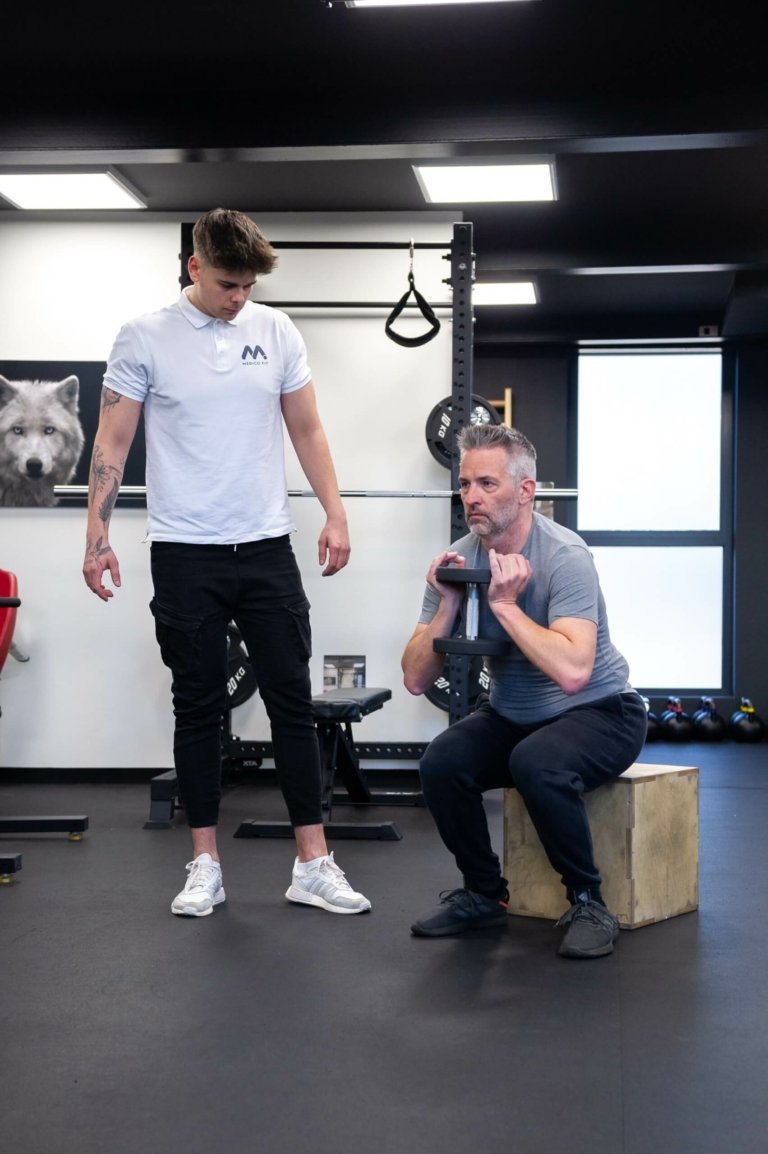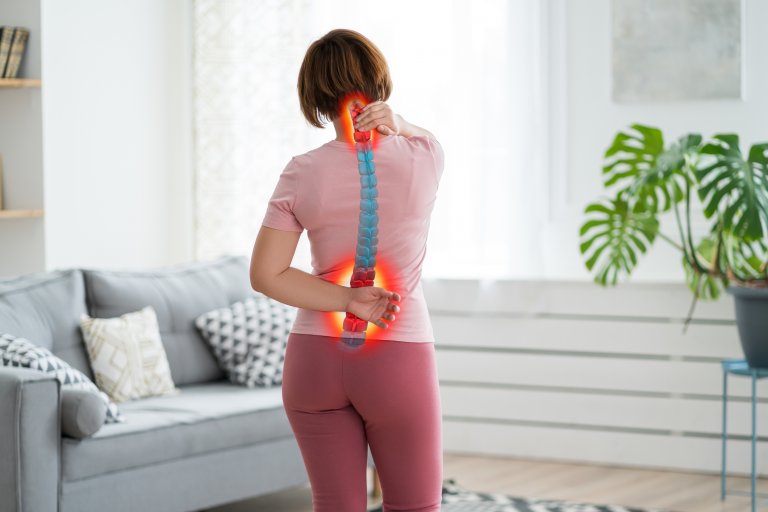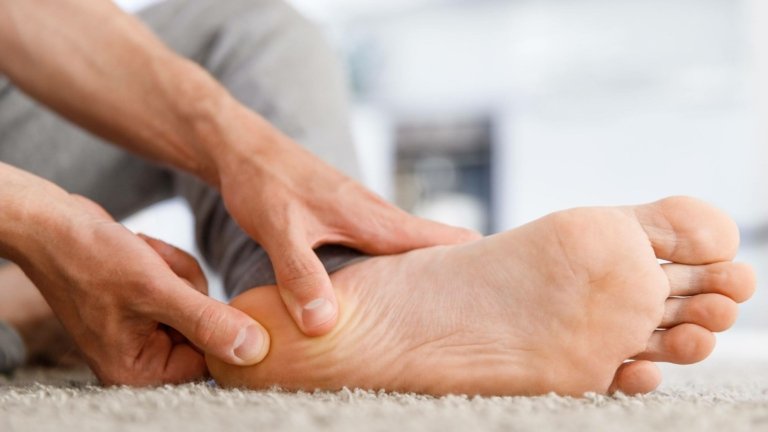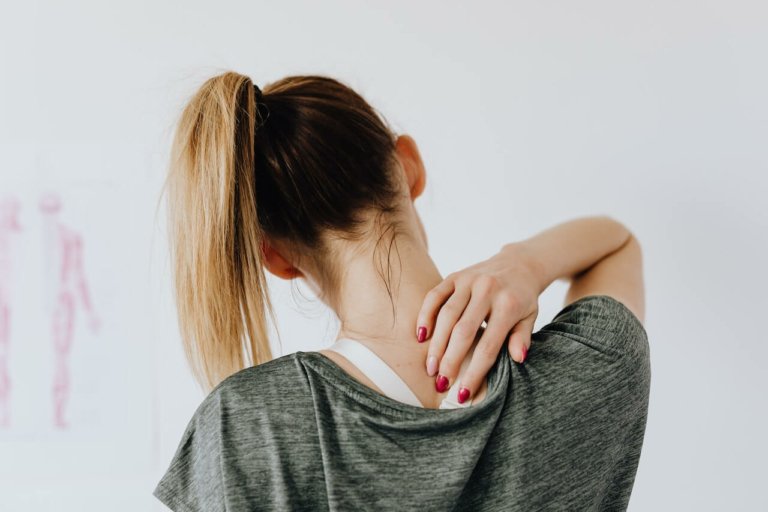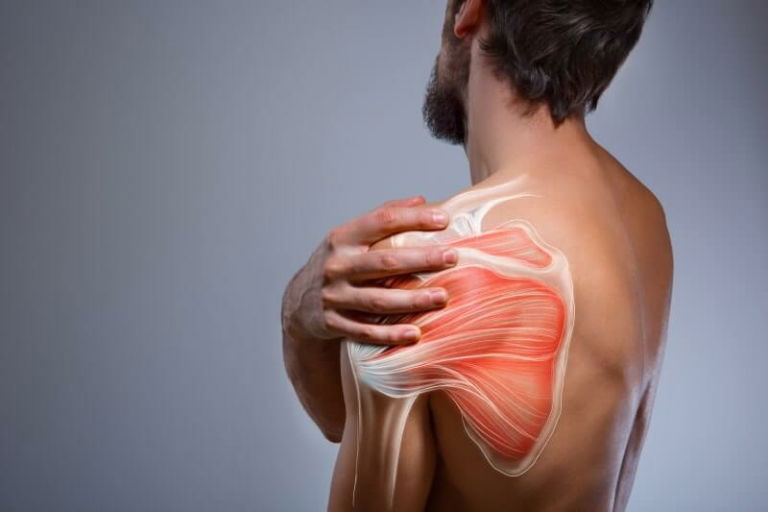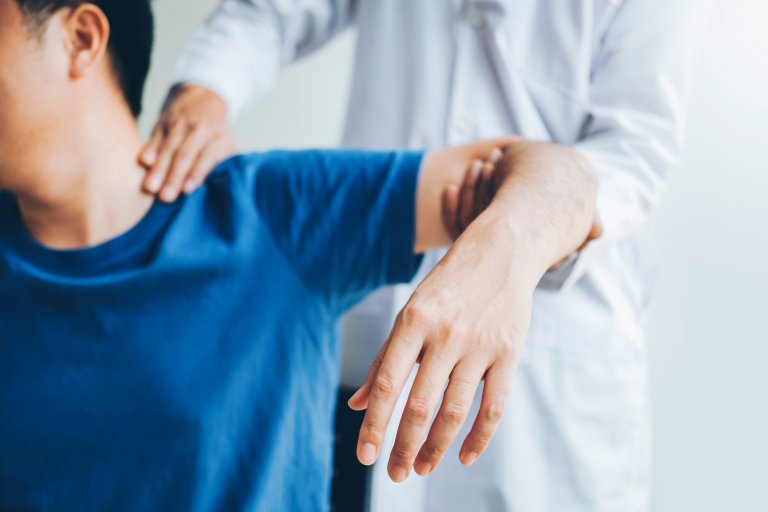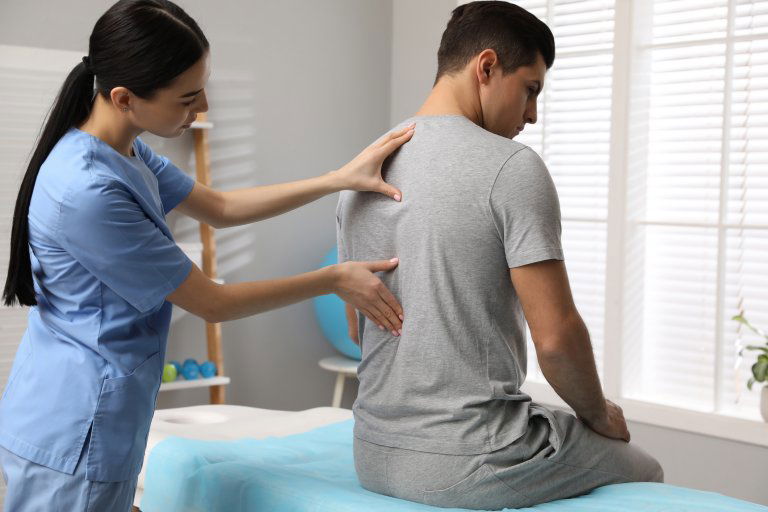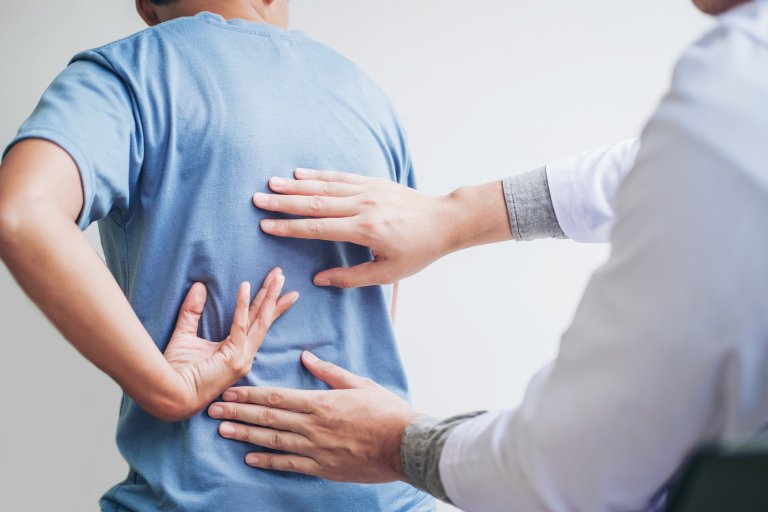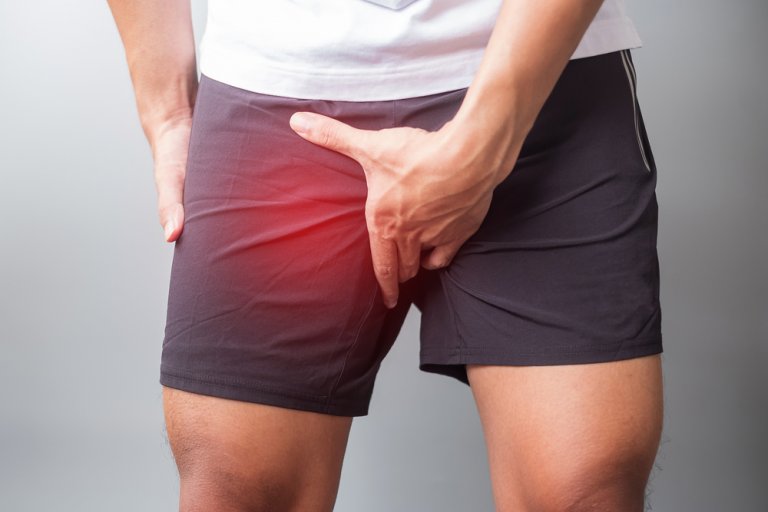Are you experiencing knee pain? Have you experienced knee pain when squatting or performing other everyday activities (walking, walking downhill, walking on stairs)?
The knee joint is the largest joint in the body, carrying the weight and loads of the entire body – which is why the knee is a site of frequent injuries and wear and tear.
It is important to determine the initial cause of the injury and pain, otherwise an innocuous pain can lead to permanent movement impairment!
Knee pain can occur because of minor injuries, such as tendinitis, bursitis, Osgood-Schlatter disease, to more serious injuries, such as arthrosis, anterior cruciate ligament tear/rupture, or meniscus injury.
Did you know that as much as 20% of the world’s population experiences painful and swollen knees? Recreational and professional athletes who play contact sports, such as football, basketball, and volleyball, are particularly susceptible to knee injuries and pain.
The most common causes of knee pain are excessive wear and tear due to repetitive movements and loads, traumatic injury (fall, sports injury), being overweight, or having a genetic predisposition.
At MEDICOFIT clinic, we have developed specialised rehabilitation protocols based on modern research and a wealth of experience, which restore full strength and movement function to your knee.
Book an appointment for knee rehabilitation
Anatomy of the knee joint
The knee joint is the largest and most complete joint in the body, consisting of the femur, tibia, and patella bones.
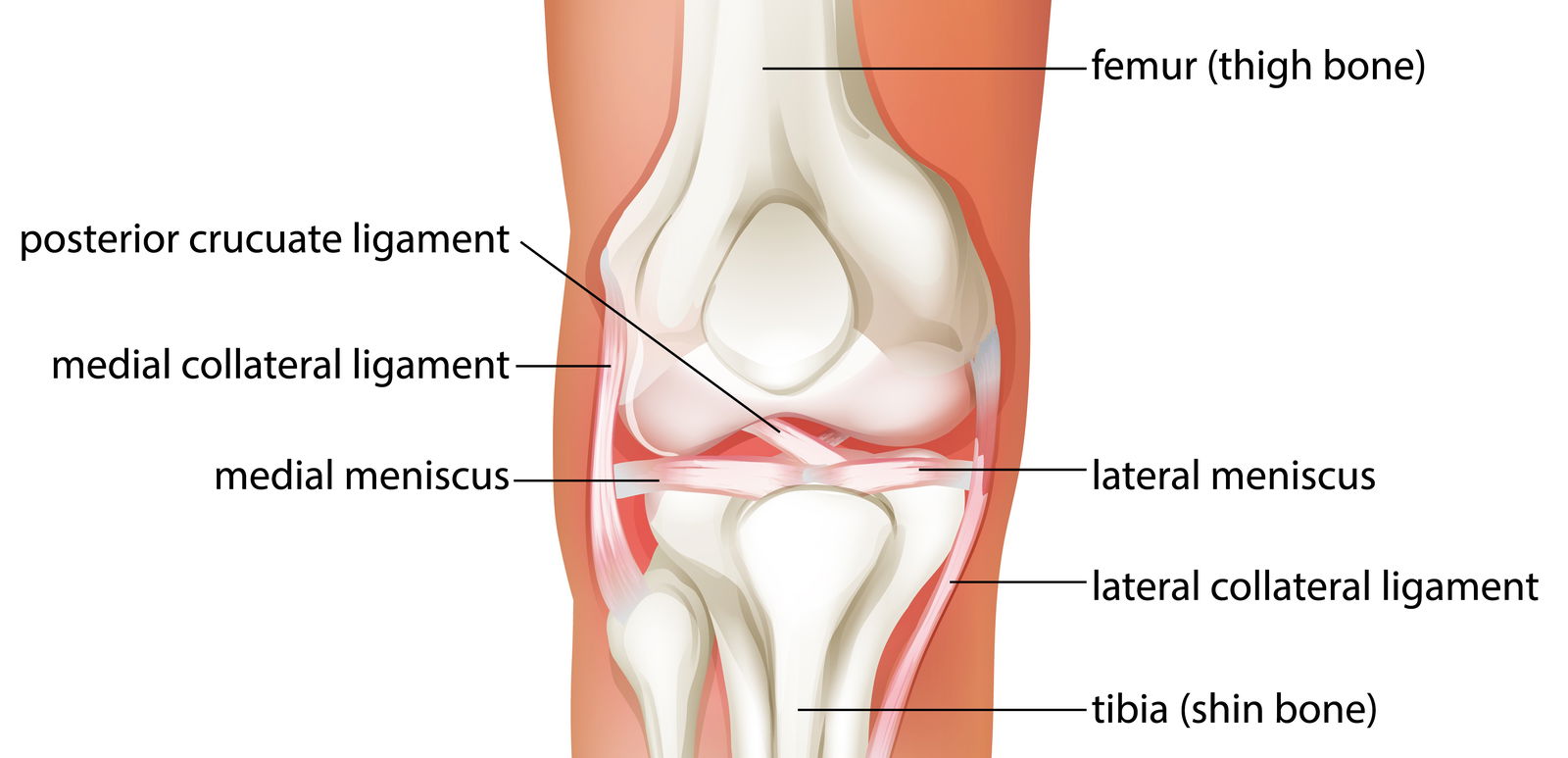
The knee is surrounded by ligaments that provide static stabilisation and prevent or stop excessive movement. The main ligaments in the knee are the anterior cruciate ligament (ACL), posterior cruciate ligament (PCL), medial collateral ligament (MCL), and lateral collateral ligament (LCL).
Ligaments, working in synergy with the muscles and other soft tissues, ensure the correct position of the knee joint and stability during movement.
A special feature of the knee joint is the two menisci (cartilage tissue) located inside the joint and acting as “shock absorbers” or load transferors.
The menisci are well innervated but have poor blood supply, meaning that the pain in the event of injury is great and the tissue’s ability to self-renew is low.
Book an appointment for knee rehabilitation
We can skilfully use the location of the pain to determine the underlying cause of your problems – it can be located anteriorly, posteriorly, medially, or laterally. The exact location of the pain is determined through diagnostic therapy.
WHEN TO OPT FOR MEDICOFIT DIAGNOSTIC THERAPY?
- When knee pain lasts longer than 14 days despite basic measures, it is necessary to undergo diagnostic therapy.
- The pain occurs during movement and limits your mobility.
- If you have had knee problems before and the symptoms are recurring, it is important to undergo thorough diagnostics.
At MEDICOFIT clinic, we provide patients with knee pain with scientifically supported specialist physiotherapy, which begins with booking a diagnostic therapy appointment.
Anterior knee pain
Anterior knee pain occurs as a result of different causes, including joint or ligament injuries, such as anterior cruciate ligament (ACL) injury, chondromalacia patella, patellar tendinopathy – jumper’s knee, anterior meniscus injuries, patellofemoral syndrome, overuse, or excessive activity.
Ligament injuries, patellar instability, or tendinopathy cause pain during movement – knee pain when squatting is especially common. Excessively intense physical activity can also contribute to discomfort.
It is important to seek the professional opinion of a physiotherapist who will be able to make an accurate diagnosis and suggest appropriate treatment based on the specific circumstances of your case.
Posterior knee pain
Posterior knee pain is a common problem that can be caused by a variety of causes. One of the common conditions associated with discomfort in the back of the knee is muscle or tendon overuse – primarily excessive activity of the popliteus muscle. This can occur with excessive physical activities that involve bending the knee or after improper rehabilitation following knee arthroscopy.
Have you ever heard of a Baker’s cyst? A common cause of pain is also a Baker’s cyst – a mucous bag filled with synovial fluid that develops at the back of the knee.
One potential cause of the problem is an injury of the posterior cruciate ligament (PCL), which connects the femur to the lower leg and can be damaged by sudden rotational forces.
It is important to note that improper joint movement or poor biomechanics can also cause pain in the back of the knee.
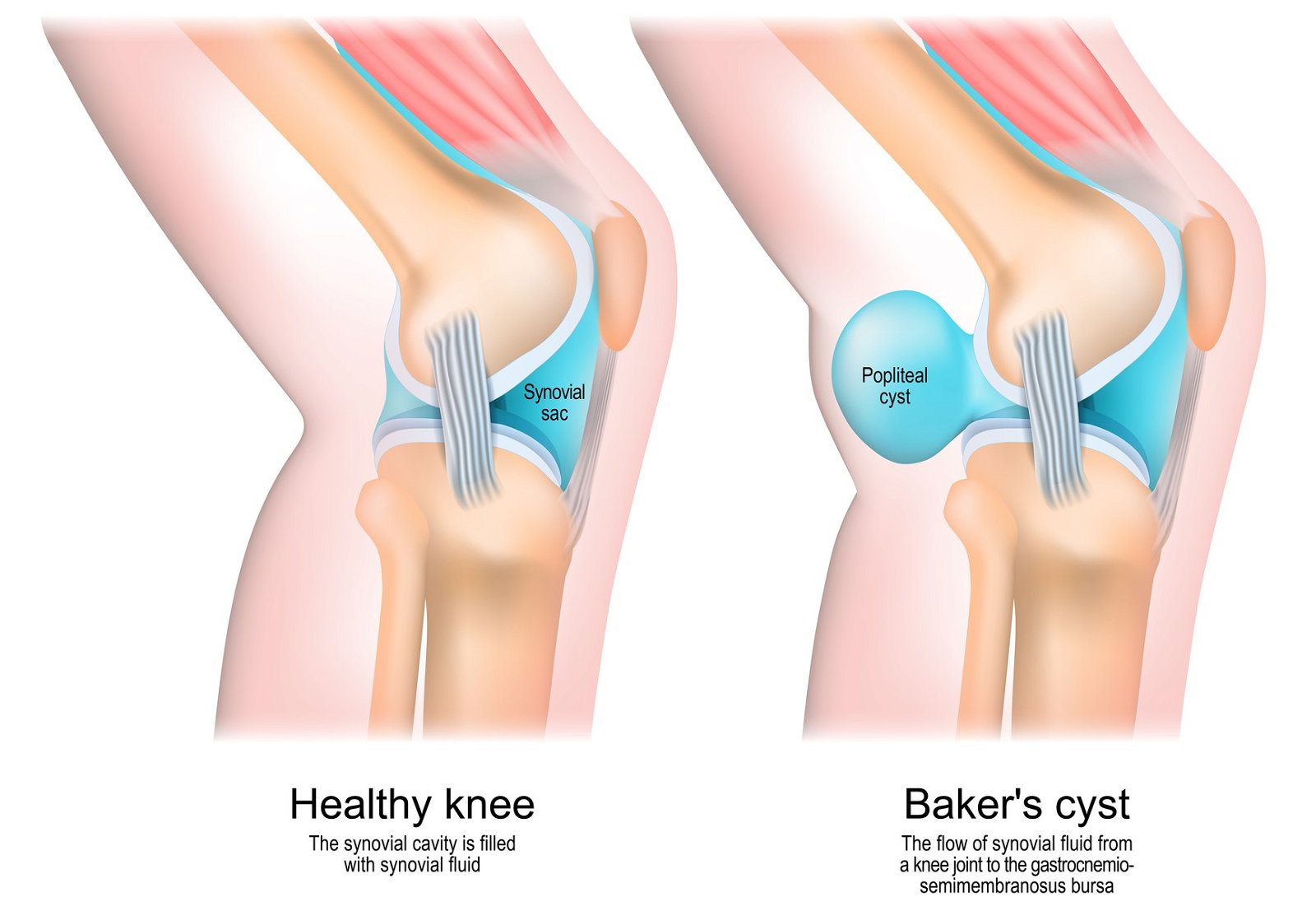
Lateral knee pain
One of the common conditions that causes this type of discomfort is runner’s knee (iliotibial band syndrome). This syndrome occurs due to inflammation or irritation of the iliotibial band, a band of tissue that runs across the outer part of the thigh.
Additionally, pain on the outside of the knee can be caused by bursitis (inflammation of the fluid-filled sacs responsible for cushioning friction between bones).
Osgood-Schlatter disease, which affects the growth plates in adolescents, is another potential cause of pain in this location.pre
Injuries to ligaments, such as the lateral collateral ligament (LCL), and injuries to the lateral meniscus can also contribute to this discomfort.
Medial knee pain
Pain on the inside of the knee is most often caused by a medial meniscus injury. The meniscus is the cartilage in the knee that can cause pain and a feeling of catching in the knee due to injury.
Injuries to the medial collateral ligament (MCL) can also cause such pain. Stretching or injury to this ligament can lead to instability and pain.
Osteoarthrosis (osteoarthritis) is another common cause of pain on the inside of the knee. This degenerative joint disease causes cartilage wear and tear, causing pain and limited mobility – knee cartilage most often wears out on the inside of the joint (a consequence of the shape of the knee).
On the inside of the knee is attachment site of muscle tendons – pes anserinus, under which lies the bursa of the same name. Overuse of these muscles can lead to pes anserine bursitis.
Furthermore, pain can also be caused by the patellofemoral pain syndrome, where the kneecap moves improperly, leading to friction and pain on the inside of the knee.
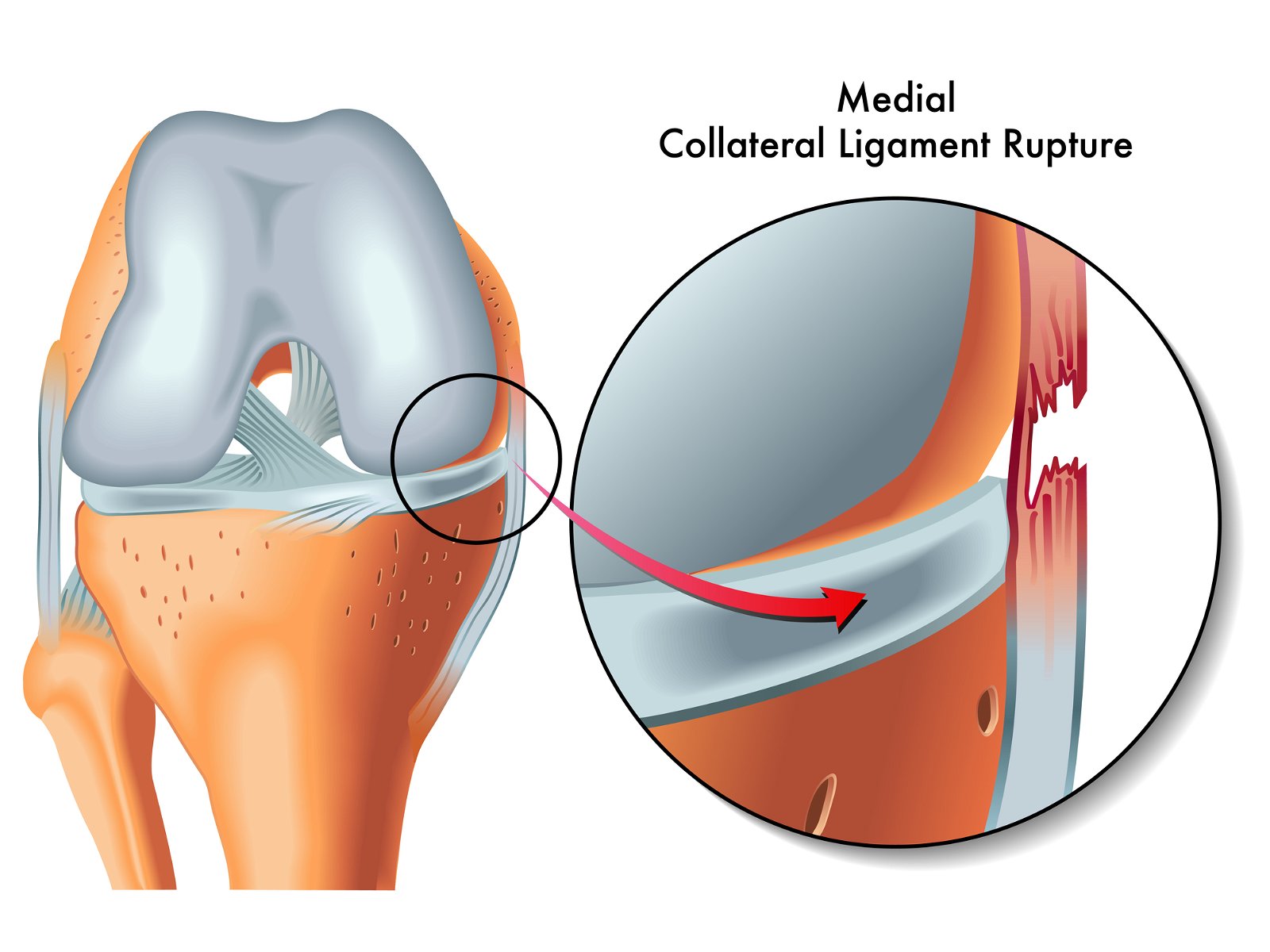
Referred knee pain
Referred knee pain is a discomfort that originates in other parts of the body but is felt in the knee. This type of pain often presents a challenge in diagnosis, as it can originate from a variety of sources. One of the common conditions that can cause referred knee pain is sciatica.
Sciatica occurs due to compression or irritation of the sciatic nerve, which extends from the lower spine to the leg. When a nerve is affected, we may feel pain along its path, which includes the knee. This type of pain is often accompanied by other symptoms, such as tingling, numbness, or weakness in the leg.
In addition to sciatica, pain from the spine or hips can also cause discomfort that projects into the knee. For example, spinal problems, such as a herniated disc or spinal stenosis, can cause pain that radiates along nerve pathways and also manifests in the knee.
Additional causes of referred knee pain include vascular diseases, arthritis in other joints, fibromyalgia, or even psychological factors such as stress, which can worsen the sensation of pain.
Treatment depends on the underlying cause and may include physiotherapy, pain management medications, muscle strengthening exercises, and, in some cases, surgery.
Book an appointment for knee rehabilitation
At MEDICOFIT clinic, we successfully treat knee pain caused by:
- anterior or posterior cruciate ligament ruptures,
- collateral ligament injuries,
- meniscus injuries,
- jumper’s knee,
- patellofemoral pain syndrome,
- Osgood-Schlatter syndrome,
- iliotibial band syndrome,
- knee instability,
- patellar instability and dislocation,
- knee arthrosis, and
- Hoffa’s disease.
Below we present four causes of knee pain that we encounter in our clinic.
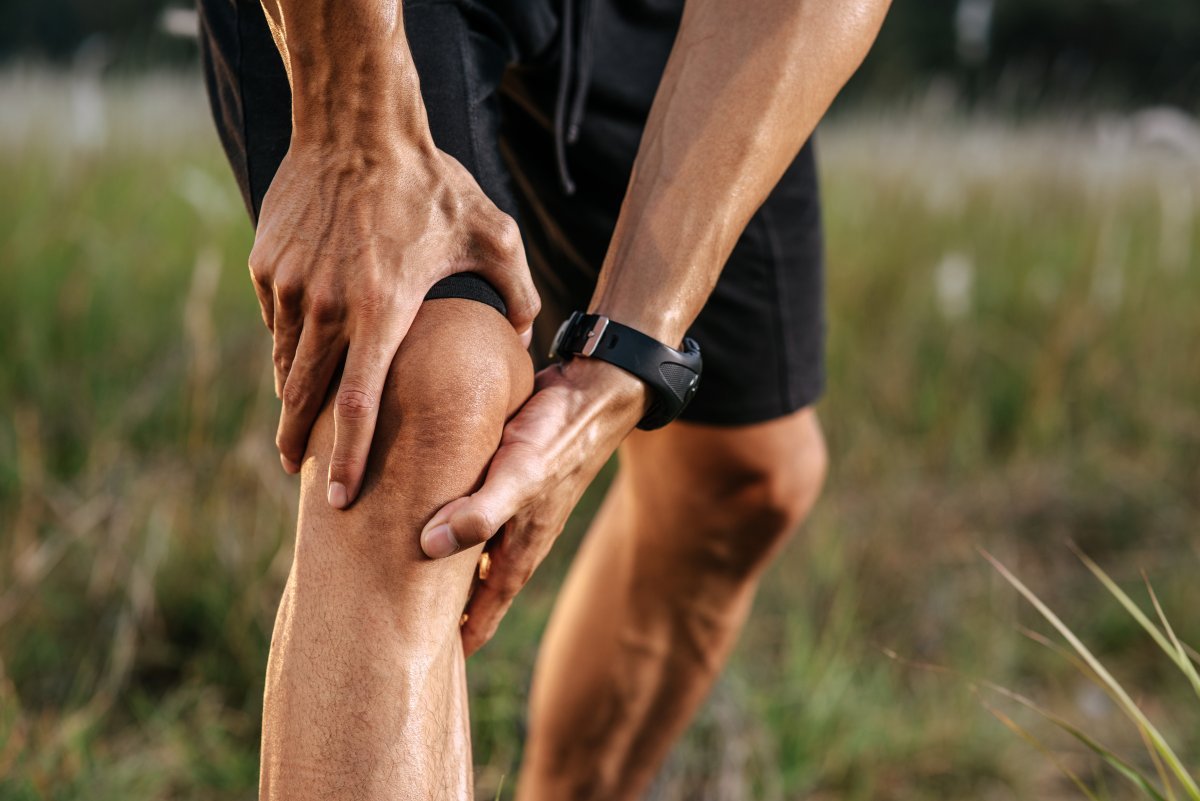
Patellar tendinopathy or jumper’s knee
Patellar tendinopathy, or jumper’s knee, is an overuse injury to the knee joint and inflammation of the patellar ligament, which attaches the patella to the tibia. It occurs due to jumps and sudden changes in direction.
The most common symptom of jumper’s knee is anterior knee pain and tenderness to the touch. Knee pain typically increases during jumping and knee bending (squatting).
Jumper’s knee most often afflicts athletes who play football, basketball, tennis, handball, and volleyball. It can also afflict runners, hikers, and track-and-field athletes.
Did you know that, if not treated properly, jumper’s knee is the main culprit for ending a sports career in 50% of cases? This means that half of all sports careers end because of jumper’s knee.
Physiotherapy treatment for jumper’s knee progresses depending on the stage of tendinopathy (there are three stages – reactive stage, tendon disrepair stage, and degenerative stage).
In all three stages, it is crucial to perform special therapeutic training to progressively strengthen the patellar ligament and asymmetrical muscle groups.
Arthrosis
Knee arthrosis is a degenerative condition that affects the cartilage in the knee joint, causing pain, reduced range of motion, a swollen knee, and reduced functionality.
It occurs due to age (reduced ability of tissue to self-renew), obesity (increased load on cartilage), traumatic knee injury or genetic predisposition.
Did you know that knee arthrosis occurs in 13% of women and 10% of men over the age of 60?
Before starting treatment for knee arthrosis, a magnetic resonance imaging scan is performed to accurately assess the extent of joint damage.
Knee arthrosis cannot be completely cured, but we can successfully control its symptoms and stop its progress.
Physiotherapy treatment to improve arthrosis symptoms includes pain therapy and anti-inflammatory therapy, special therapeutic exercises to maintain range of motion and muscle strength and generally improve physical fitness.
At MEDICOFIT clinic, we successfully prepare patients for knee replacement surgery (partial or total endoprosthesis of the knee) in the pre-operative and post-operative rehabilitation phases.
Book an appointment for knee rehabilitation
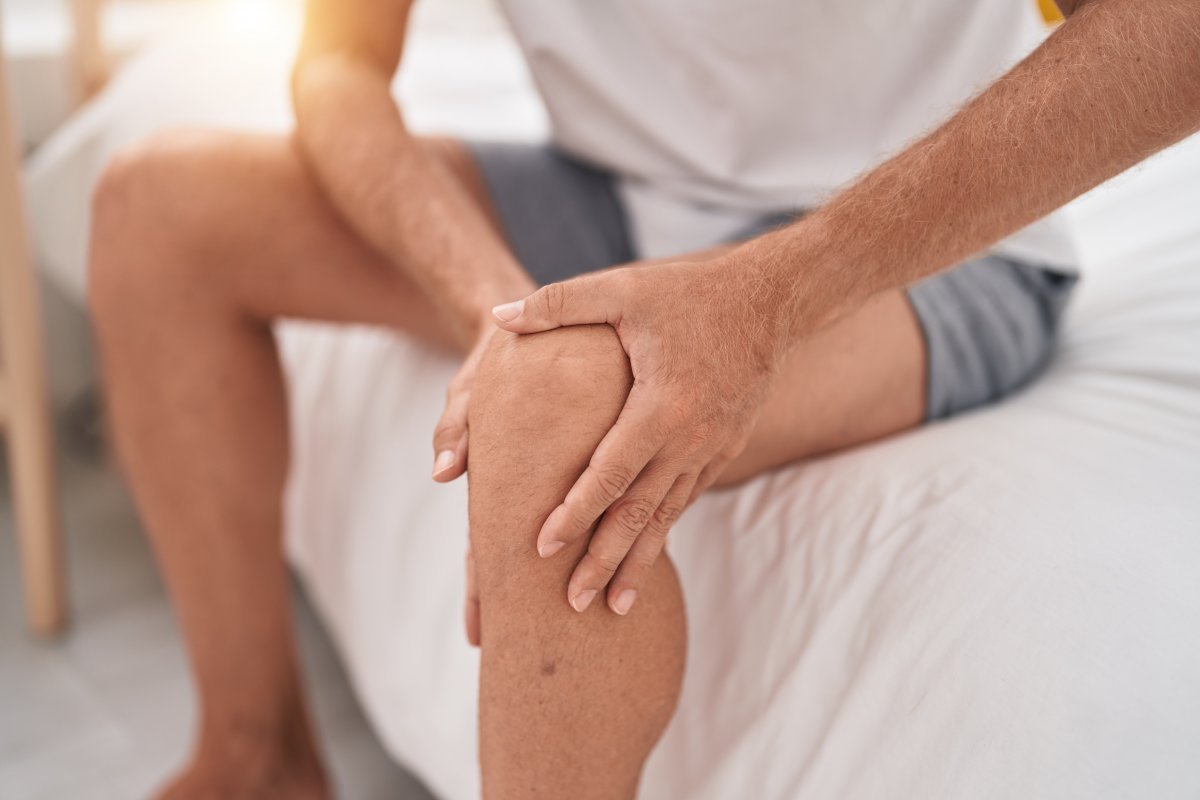
Bursitis
Knee bursitis is a condition affecting a bursa and causing an inflammation (you can think of it as a small fluid-filled sac that helps with movement).
An inflammation most often develops as a result of excessive wear and tear (repetitive movements and use), injury (prolonged kneeling), or direct traumatic knee injury.
Did you know that knee bursitis most commonly develops in construction workers, gardeners, and floor installers?
The main goal of physiotherapy rehabilitation is to reduce pain and inflammation, improve mobility, and prevent the recurrence of bursitis.
Specialist physiotherapy includes manual therapy (joint mobilisation, trigger point therapy), special therapeutic exercises (to strengthen muscles, increase mobility and balance), and the use of instrumental devices (TECAR therapy, laser therapy, HiToP electrostimulation).
Osgood-Schlatter syndrome
Osgood-Schlatter syndrome is a medical condition that can affect growing children and teenagers. It occurs due to a disruption in the normal process of bone development and causes inflammation in the patellar ligament, which attaches the patella to the tibia bone.
The most common symptoms are pain, which typically worsens with physical activity, and a bulge that is tender to the touch.
It most often occurs in athletes who do a lot of running, jumping, landing, and changing direction (repetitive knee flexion and extension movements).
Physiotherapy treatment for Osgood-Schlatter syndrome is long-term, lasting from four months to several years. The athlete gradually returns to activity as the acute symptoms (reduction of pain and reduction of inflammation) subside and the knee musculature is strengthened through a progressive training programme.
Athletes return to sports activities within 10 to 15 weeks; however, special therapeutic training continues for at least the next 10 weeks.
Comprehensive treatment of knee pain
At MEDICOFIT clinic, we believe in comprehensive treatment, where we guide the patient from diagnostics and physiotherapy to kinesiology.
We ensure long-term effective treatment results using active physiotherapy and individualised treatment, which lasts 90 minutes.
Diagnostic therapy
Every physiotherapy treatment begins with diagnostic therapy, where a physiotherapist specialised in your specific condition gains insight into the causes of the disease, symptoms, and physical limitations.
The diagnostic examination begins with an initial interview (anamnesis), where the patient explains about the history of the disease, when the knee pain first appeared, how long it lasts, when it gets worse, and shares all relevant information that helps us understand their condition.
This is followed by a physical examination with inspection and palpation (examination of swelling, inflammation, tenderness, skin colour, tissue temperature).
Mobility and arthrokinematics measurements, as well as muscle strength measurements, are performed, which provide insight into muscle strength, endurance, and proportion in their function.
An assessment of the load-bearing capacity of the knee and the biomechanics of walking (potential deviations from norms) are performed.
Functional tests are performed, such as the Lachman test (to check the stability of the anterior cruciate ligament), the McMurray test (to check for potential meniscus damage), the valgus stress test (to check for potential damage to the internal lateral collateral ligament), and the varus stress test (to check for potential damage to the external lateral collateral ligament).
In certain cases, diagnostic imaging such as X-ray, magnetic resonance imaging, and ultrasonography is recommended to determine the extent of the injury and to rule out differential diagnoses.
Based on the diagnostic report, an individualised physiotherapy programme is prepared, aimed at controlling symptoms and eliminating the cause of knee pain.
DANGERS AND PITFALLS OF DELAYED REHABILITATION

MEDICOFIT specialists
- Without specialist rehabilitation for knee pain, the pain can turn into a chronic condition that is more difficult to cure and carries high risks of surgery.
- Inadequately treated pain leads to compensatory movements that cause premature degeneration of the knee joint.
- Knee joint instability has been shown to lead to secondary injuries to ligaments, meniscus, and cartilage.
Inadequate or delayed rehabilitation seriously jeopardises an individual’s long-term physical health and is the main culprit for unsuccessful results and permanent movement limitations.
Acute physiotherapy
In the acute phase of physiotherapy treatment, we perform symptom control (reducing knee pain, reducing inflammation and swelling, increasing mobility and increasing muscle strength).
Book an appointment for knee rehabilitation
Physiotherapy experts perform manual therapy, joint mobilisation, transverse friction massage (e.g. for jumper’s knee, transverse friction massage of the inferior/lower part of the patella is performed), trigger point therapy (e.g. on a constricted large thing muscle that tightens the patella and patellar ligament), and myofascial release with the aim of reducing muscle tension, increasing the range of motion in the knee, and reducing knee pain.
In combination with instrumental therapy, where we use state-of-the-art devices:
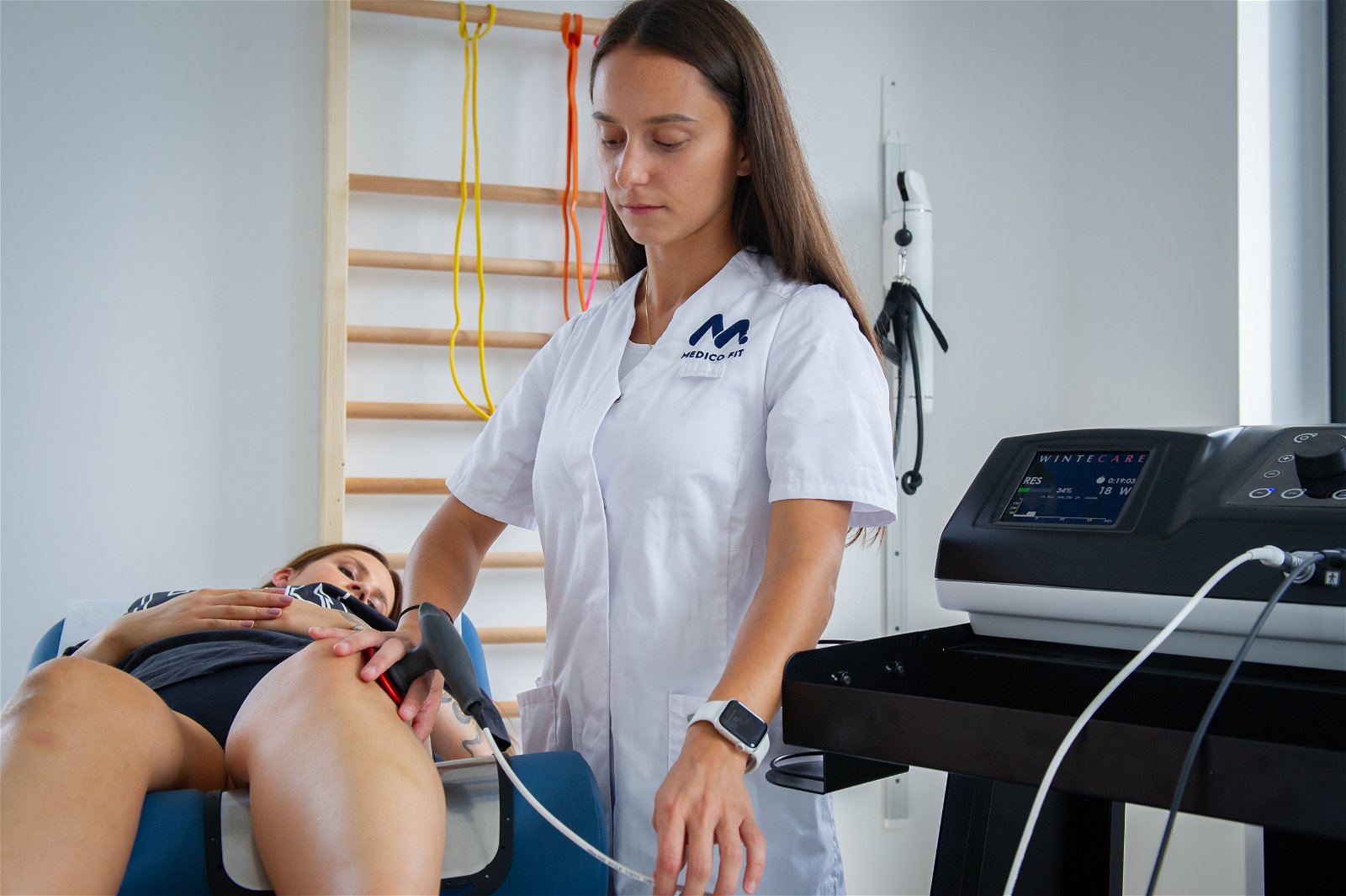
It is crucial to perform a tailored special therapeutic training for each patient individually, their injury, and the demands of everyday stress (e.g. sports).
In the acute phase of treatment for jumper’s knee, isometric contractions (several sets of 45 seconds) and isotonic contractions (exercises that place stress on the patellar ligament) are started. Once the norms have been sufficiently achieved, the training continues with progressive plyometric loading.
Special therapeutic training for treatment of Osgood-Schlatter syndrome focuses on performing isometric contractions of the thigh muscles in the first four weeks, with exercises using one’s own weight starting only after the fifth week, progressively continuing to strength training for the anterior and posterior thigh muscles. Proprioceptive training, stretch training, and strength training for gluteal muscles, hip adductors, and calf muscles are gradually introduced.
Post-acute kinesiology
After successfully completing the physiotherapy phase, treatment continues into the kinesiology phase, where kinesiology experts guide the patient to excellent physical fitness.
Special kinesiology training for treating jumper’s knee focuses on strengthening the posterior thigh muscles and the anterior thigh muscle, with an emphasis on loading in larger ranges of knee flexion.
With progressive training, the load-bearing capacity of the quadriceps tendons gradually improves, meaning that they are able to transmit body loads more efficiently and that complete symmetry of muscle strength between the posterior and anterior thigh muscles is achieved.
Special kinesiology training improves proprioception in both knees and gradually includes the injured area in performing more complex motor tasks.
In the case of sports rehabilitation, progressive plyometric training is included in the programme, which is focused on sport-specific loads.
Before completing treatment for knee pain, a biomechanical analysis of body samples and a knee test battery are performed to determine movement efficiency and treatment progress.
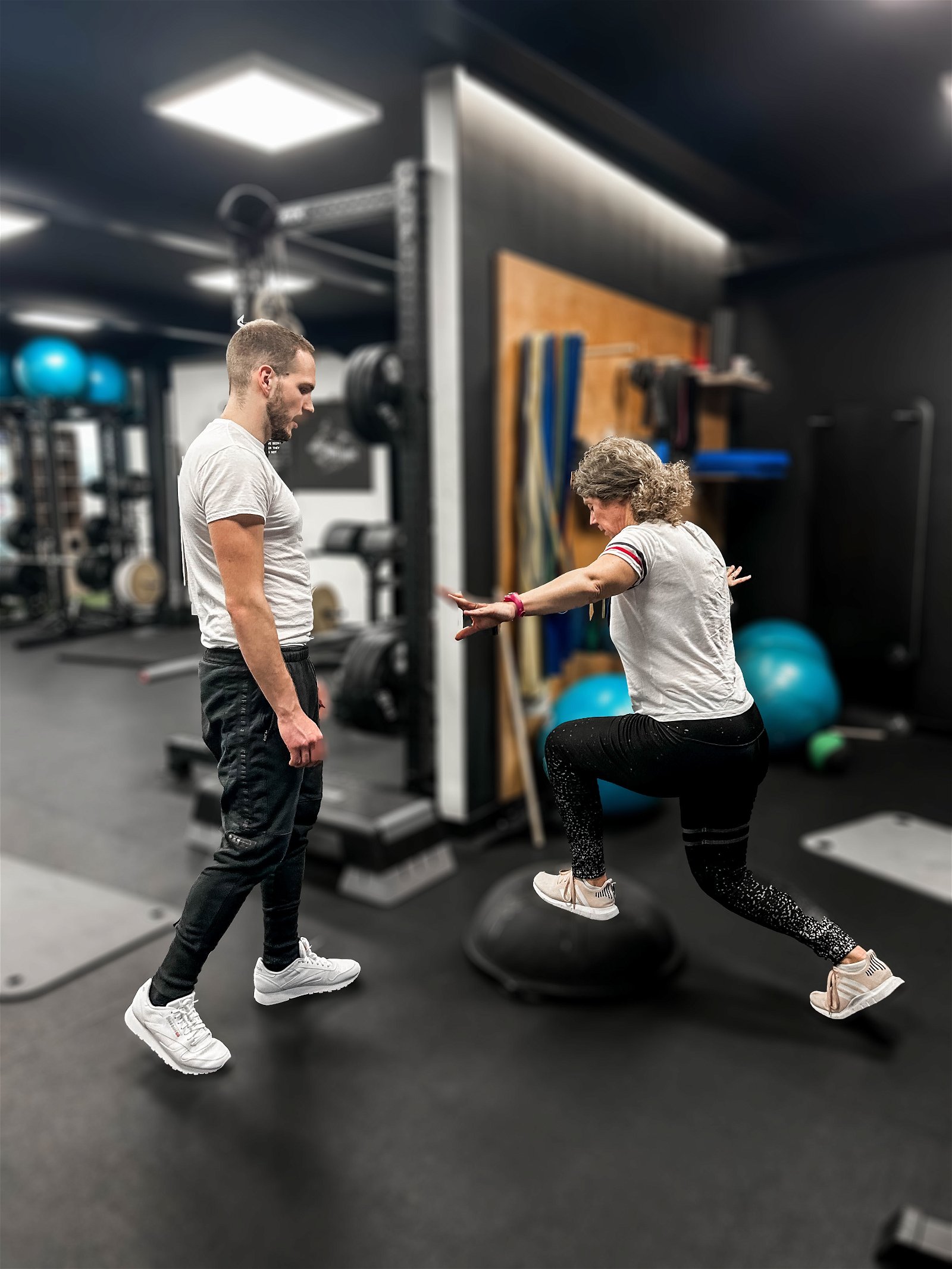
Preventive kinesiotherapy
At MEDICOFIT clinic, after successful completion of physiotherapy treatment for knee pain, patients take part in the post-kinesiology programme.
The post-kinesiology programme includes special training for the knee and strengthening of the entire body.
This is a preventive kinesiology programme that actively prevents the recurrence of old injuries and the occurrence of new injuries.
The individual is thus more effectively prepared to withstand the daily and unexpected stresses placed on their body.
Because we believe in a comprehensive treatment, we guide the patient from diagnostics to kinesiology, where kinesiology experts restore full strength, movement function, and resilience to your knee!
WHY CHOOSE SPECIALIST PHYSIOTHERAPY TREATMENT?
- We ensure high treatment success and long-term results.
- Up to 90% lower risk of knee surgery!
- We offer state-of-the-art non-invasive treatment methods that provide optimal conditions for the healing of knee joint injuries.
Comprehensive treatment of knee pain at MEDICOFIT clinic is recommended by numerous renowned orthopaedic surgery specialists.
Frequently asked questions
What is the most common cause of knee pain?
In adults, the most common cause of knee pain is likely osteoarthrosis, which accounts for as many as 80% of cases of pain. In younger individuals, pain is most often the result of an acute injury – such as an anterior cruciate ligament or medial meniscus injury.
When is it necessary to see a doctor for knee pain?
If you have chronic pain or have had a knee injury, it is recommended to see a doctor for a proper diagnosis. Often after an injury, the swelling goes down and the pain subsides, but if you do not receive proper physiotherapy rehabilitation, the injury can lead to additional problems and movement limitations later in life.
How to prevent knee pain?
Maintaining a healthy weight is key to maintaining healthy knees. It is also important to regularly do exercises for increasing mobility and strengthening the entire leg. If you play a sport that requires a lot of physical effort, such as skiing, tennis or football, it is essential to maintain good physical condition.
How should I sleep if I am experiencing knee pain?
For a comfortable position while sleeping, use a pillow to support painful areas. We recommend that you place the pillow between your knees if you sleep on your side, or under your knees if you sleep on your back.
Book an appointment for knee rehabilitation
- Bunt, C. W., Jonas, C. E., & Chang, J. G. (2018). Knee Pain in Adults and Adolescents: The Initial Evaluation. American family physician, 98(9), 576–585.
- Hsu, H., & Siwiec, R. M. (2022). Knee Osteoarthritis. In StatPearls. StatPearls Publishing.
- Katz, J. N., Arant, K. R., & Loeser, R. F. (2021). Diagnosis and Treatment of Hip and Knee Osteoarthritis: A Review. JAMA, 325(6), 568–578. https://doi.org/10.1001/jama.2020.22171
- Muaidi Q. I. (2020). Rehabilitation of patellar tendinopathy. Journal of musculoskeletal & neuronal interactions, 20(4), 535–540.
- Rishor-Olney CR, Pozun A. Prepatellar Bursitis. [Updated 2022 Sep 6]. In: StatPearls [Internet]. Treasure Island (FL): StatPearls Publishing; 2022 Jan-. Available from: https://www.ncbi.nlm.nih.gov/books/NBK557508/
- Smith, J. M., & Varacallo, M. (2022). Osgood Schlatter Disease. In StatPearls. StatPearls Publishing.








